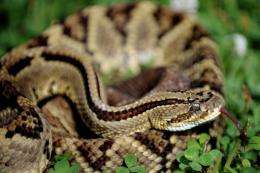A poisonous neotropical rattlesnake (Crotalus simus) is pictured at the serpentarium of the Clodomiro Picado Institute in Coronado, near San Jose. The Institute develops snake poison antidote for Costa Rica and other Latin American countries.
The dreaded Matabuey, a snake so fearsome its name means "ox killer," has a deadly bite that immobilizes its prey in minutes, making it the kind of creature generally to be avoided. But far from steering clear of the legless lizards, researchers at the world leading Clodomiro Picado institute in Costa Rica are avidly cultivating them, along with hundreds of equally-venomous vipers.
Scientists raise the deadly reptiles to harvest their venom, the key ingredient in the massive quantities of life-saving antivenom produced by the institute each year from some 800 snakes.
Venom from the Matabuey and other pit-vipers, known in English as bushmasters, helps herpetologists produce the serum administered to snakebite victims around the world who would otherwise face certain death.
Poisonous snakes raised in this research facility about a dozen miles (20 kilometers) north of the Costa Rican capital San Jose are kept in meticulously labeled glass containers for the sole purpose of collecting their venom.
The poison is extracted from the snakes "three or four times a year," said herpetologist Fabian Bonilla, who once survived the potentially lethal bite of a coral snake -- another viper in the institute's impressive collection.
For researchers in this subtropical country, where a host of venomous snakes flourish, the extraction of venom is so methodical that it has an almost ritualistic quality.
"The animal does not eat for two weeks before the extraction," said Bonilla, explaining that many snakes also use venom to digest their prey and therefore the amount of poison they produce diminishes greatly after they have eaten.
"Afterwards, it needs time to de-stress and eat well," since the extraction process "is very stressful for the animal," he said.
The director of the institute, Yamileth Angulo, revealed that the use of horses is the crucial next step in the production process.
The animals are injected with small, nonlethal doses of venom for three successive months, producing antibodies in their blood.
A small amount of the horse's blood is then removed and plasma is extracted containing the vital antibodies which, when injected into a snake bite victim, will neutralize its venom.
"When we see that the horse has responded well and has produced large quantities of antibodies we extract some of its blood -- about eight liters of blood each day for three days from each horse," Angulo said.
After separating out the red blood cells from the plasma, the blood is reinjected into the horse.
"That way, we ensure that nothing bad happens to the animal," explained Angulo.
Soon after being captured in the wild, the snakes are placed in quarantine and checked for parasites.
Once given a clean bill of health they are "milked" for their venom, and fed a diet corresponding to what they might have eaten in the wild -- usually dead rodents or in the case of corals, smaller snakes.
But despite the fastidious care they receive at the center, their lives here are often short.
"Many die because they do not adapt quickly to captivity," admitted biologist Aaron Gomez.
The institute, which operates under the aegis of the University of Costa Rica, manufactures 100,000 doses of snake antivenom, which is sold throughout the Americas as well as Africa, Papua New Guinea, Australia and Taiwan.
Thanks to an agreement reached with the World Health Organization, it also provides the medicine to various African countries for the greatly discounted sum of about 20 dollars per dose "just to covers our costs," Angulo said.
At market rate the life-saving antivenom can cost as much as 1,000 dollars per dose, he said.
Since each family of snake has its own antidote, the institute has an agreement with Liverpoool University in Britain, which also has a large collection of venomous snakes.
The British university sends it venom from some of the snakes in its collection, allowing the Costa Rican institute to create a broader array of snake antivenom.
(c) 2010 AFP




















